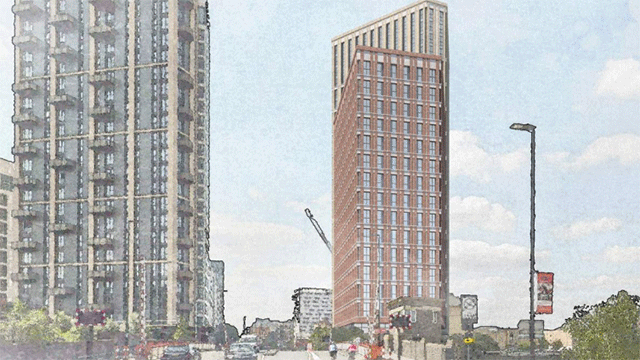When Geeta Nanda started her career in housing in the 1980s, there were few celebrity chief executives for a young professional to look up to. But in the decades since, housing associations have expanded with some notable figureheads leading the charge.
Today that leadership is in flux. L&Q’s David Montague, Peabody’s Brendan Sarsfield, Places for People’s David Cowans and Hyde’s Peter Denton have all left their chief executive roles in recent months.
Nanda is philosophical about the level of change at the top of the industry. “I always say, as long as we keep them in the sector, that’s a good thing,” she says. “People move between the private sector and [housing associations]. You’re all growing talent for this industry.”
As chief executive of housing association Metropolitan Thames Valley since 2017, and head of Thames Valley Housing Association for the nine years leading up to its merger with Metropolitan Housing Trust, Nanda is now eager to use her own leadership position to encourage a more diverse workforce.
“It causes a change as people leave and somebody else steps up,” she says. “It’s a really good time for people to think about their next opportunity and for us to think about diversity in the sector.”
Shifting the dial
Nanda first worked in housing as a graduate trainee with Wandsworth Council. Wandsworth offered graduates experience in three different directorates, starting with housing, then finance and education. She never made it to the final pillar, instead opting to pursue housing research and later moving to her first role with Notting Hill Housing Trust.
“As soon as I walked in, I thought ‘I’ve found my place’,” she says. In those early days her biggest inspiration came from the people she worked with – Notting Hill’s chief executive Kate Davies among them. “She encouraged me to go for a chief executive job – I hadn’t really thought about it until that point,” says Nanda. But there were few leadership positions to aim for. “People said ‘there will be jobs, they all come at the same time’,” Nanda says – and eventually they did.
Nanda joined Thames Valley Housing Association as group chief executive in 2008. Since then she has overseen the merger with Metropolitan and expansion to a portfolio of 58,000 homes. The company launched one of the first BTR specialists, Fizzy Living, and in 2013 Nanda was awarded an OBE for her services to social housing.
She has since taken on several other board roles and last month became chair of the G15, the group of London’s largest housing associations, with a collective portfolio of more than 600,000 affordable homes.
As she leads the organisation over the next two years, the G15’s commitment to diversity in the sector will be a priority. During her tenure as G15 vice-chair, she is proud to have overseen rapid improvements in the group’s board diversity. When the housing associations came together during the pandemic, they saw an opportunity to collaborate in changing the sector’s inclusivity and representation. “There were a lot of things we had to change,” says Nanda. “We brought in the headhunters and asked them ‘what are you doing differently?’. We spoke to conference organisers and said ‘we’ve got a list of people in our organisations [that can speak at events]’.”
The companies’ chairs signed up to a target to have 30% of board members from ethnic minorities by 2025. “Because board positions change more frequently than executive positions, there is more of a flow-through, it’s easier to start shifting the dial on something like that,” says Nanda. That’s not to say the group isn’t aiming for bigger change at the executive level too – the G15 Accelerate programme now also provides chief executive face time and courses for aspiring BAME leaders.
Interconnected tunnels
Nanda is taking the helm at the G15 at one of the most difficult times for housing associations. “It is critical and it is challenging and there is no clear way through,” she says.
She is focused on addressing building safety, the climate crisis and leading communities and new development in the recovery from the pandemic. To do this, she says, organisations will need a shake-up, moving from long-term thinking to embrace agility in their response to new uncertainties.
“It is going to be a bumpy ride over this time,” says Nanda. “We have got to keep making decisions and keep doing things, even if we can’t see the clear view through to the end. It’s just not going to be that clear. We are going to have to go round lots of corners, up and down tunnels. We have to get used to working differently as a result.”
The G15 estimates it will collectively spend £2.9bn on cladding remediation between 2019/20 and 2031/32, although this could rise depending on government guidance. We speak just a week after the release of the Building Safety Bill, with 218 pages of new regulation but still many questions unanswered.
“The cost to the leaseholder, who is going to bear these costs, how they are going to be recovered, the work that is required to do that and how we risk-prioritise our buildings – that’s not in there and that’s the biggest need for us right now,” says Nanda.
She and other leaders in the sector will be working to ensure support for building safety to ultimately deliver more affordable housing. “All of these things interconnect,” she adds. Racing to meet the costs of decarbonisation and retrofitting could lead to a sale of stock as a quick fix, rather than finding affordable solutions. “Is that what people really want? A sell-off of more social housing to the private sector?” Nanda asks. Her tone suggests that is not the right response.
Private relationships
Institutional involvement in affordable housing has long been contentious – but Nanda, like others in the industry, believes there is a growing place for private capital in the sector, providing a balance can be struck.
“I think it’s really important for us to keep developing in our own right,” she says. “As a housing association we have a wonderful business model where all our surplus goes back into the organisation, any grant we get we recycle back. It’s a very neat business model, which means you have longevity as an organisation.”
Private sector involvement has its value, she adds, applauding the “strides by the M&Gs and L&Gs” to deliver more affordable housing. But the need for returns disrupts the traditional model.
Nonetheless, for housing associations to keep up supply in the face of rising costs they need to explore new business models. “Our current business plan means our development potential on our own balance sheet will go down,” says Nanda. “You’ve either got to build in cheaper areas so your subsidy level per homes is less, get more grants or find a partner that is willing to invest in this area.”
MTVH has several initiatives with private partners. The housing association has sold private blocks to Gresham House’s ReSI and also provides sales and management services under SO Resi to ReSI and Croydon’s Brick by Brick. And it has longer-term strategic partnerships with much wider ambitions.
Opal, the company’s joint venture with Vistry Partnerships, is currently on-site delivering MTVH’s biggest scheme of 975 mixed-tenure homes at Brunel Street Works in Canning Town,E16. At that site, Fizzy Living has taken 292 flats for Fizzy East16. Nanda co-founded Fizzy in 2012 in the wake of the market crash, bringing on investment from Abu Dhabi Investment Authority as a majority shareholder. MTVH today retains 16% of the company, though that stake has also attracted bids from the private sector.
In a downturn there’s a greater call for private sector involvement, but Nanda says there is an art to working these out and how and when to scale these deals. “You do your first deals and you see what happens and you have an ambition,” says Nanda, adding that associations must still be careful that long-term ambitions are aligned. “The type of organisations and the type of partnerships is really important. We don’t want to be seen as easy pickings.”
There is no formula for this, Nanda adds. It depends on need, but also the history and specialisms of individual associations. “It’s the ethos of housing associations – can you get a market going? It’s in our DNA really to say ‘what can we do now?’”.
That DNA is what led to the regeneration of streets in Notting Hill and Brixton, or the establishment of a BTR platform years before UK capital jumped in. Luckily for inexperienced organisations, it’s a very different industry compared to those early days. And as the industry prepares for coming challenges, now there are more leaders to look up to.
To send feedback, e-mail emma.rosser@eg.co.uk or tweet @EmmaARosser or @EGPropertyNews











